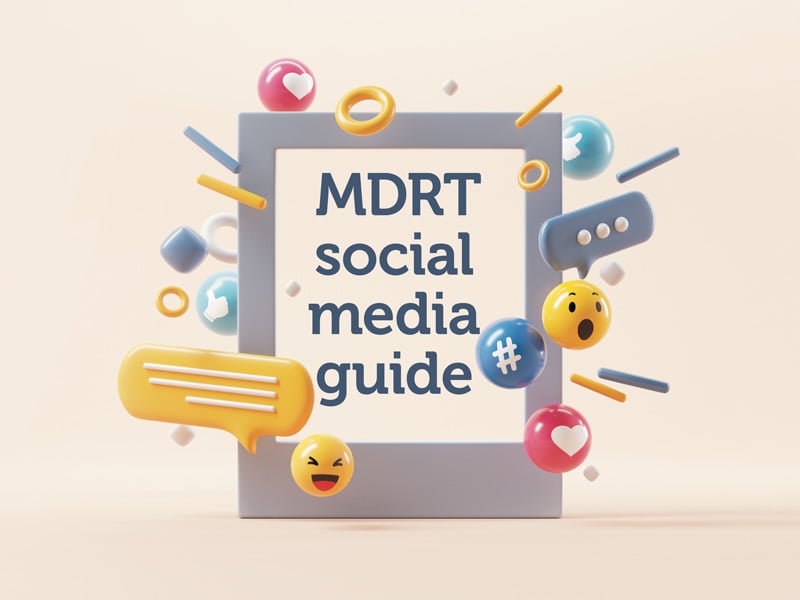Nov 01 2023 / Round the Table Magazine
MDRT social media guide
Topics Covered
A long time ago, all contact with clients took place in person or over the phone. Clearly, those days are gone and not coming back. The good news is that social media provides an expansive opportunity for you to reach clients and prospects in new ways.
Across numerous platforms, you can customize your approach to best fit your brand and services as an advisor, as well as the target market you want to reach. The possibilities are immense, and you get to choose what works best for you.
Discover how you can maximize the benefits of social media in your practice in the following excerpt of the MDRT social media guide. Find the complete version, with insights about what to post and how to use different approaches for different platforms, at mdrt.org/social-media-guide.
Why advisors should care about social media
Before diving into the many possibilities of social media, let’s review just some of the reasons it can benefit you:
- Building your own community with trusting, walk-in prospects asking to join
- Creating your own ecosystem within your clientele to increase loyalty and add massive value beyond finance
- Demonstrating your personality to amplify your work and distinguish your practice
- Converting your lifestyle prospects to loyal clients
- Showing up as your highest and most authentic self to attract your desired clientele
- Utilizing the power of infinite connections to break into new markets
- Educating multiple people rather than individuals
- Marketing yourself for much less than the cost of traditional advertising
- Remaining at the top of your clients’ minds without engaging them in person
Some basics to know before getting started
If there’s one universal truth about social media for advisors, it’s that with many platforms come different people and different content. It is not a situation where one size fits all and you can simply copy and paste one piece of content into every social media destination.
Instead, familiarize yourself with the differences between the platforms to understand how, for example, people best interact with material on Facebook vs. LinkedIn vs. X (formerly Twitter) vs. TikTok.
Different types of clients will find you in different places based on what you post and where, and it’s important to match what you say to who you want to hear it. What can your audience learn from you? What do they want to know, and how often will you deliver that content?
Meanwhile, don’t make assumptions about who is out there in the digital space. Studies may indicate particular social media use by millennials and Gen Z (providing an opportunity to educate these markets in ways they may not have received before), but that doesn’t mean everyone seeing your posts is younger than 40. There’s room for people on social media to be interested in their first insurance policy, college planning, retirement planning and everything in between.
In addition, authenticity is key. It’s better to collaborate with an expert than pretend to be a resource about something you don’t know much about. Social media is a place where you can drive conversation, and that includes asking questions, and liking and commenting on your networks’ content in addition to posting your own (and responding to comments posted there). Just like in your offline conversations, showing authentic interest is much better than simply looking to make a sale.
As with any initiative, make sure you are clear on all relevant regulations and compliance guidelines before diving into the social media world. In many cases, compliance departments require extensive review of material that is posted. It is also important to ensure there is no sensitive material online that can be attributed to you.
What to do
Know your identity. This means, among other things, how your social media accounts are branded and what voice they use. Make sure your photos, logos, color scheme, tone of the writing, and any other details that define the way others see you have been thoughtfully considered and executed across all platforms, so clients see you as a professional resource no matter where they find you. Knowing your identity also means understanding why you are doing this in the first place. Are you trying to generate leads? Build brand awareness? Drive traffic to your website? Advisors know how important it is to know their why, and that applies to social media too.
Embrace personalization. Posts about your team, or individuals on it, may get more engagement than business-related information. Recognize that people want to know about other people, so posts that highlight personalities through information, imagery or otherwise can go a long way in driving engagement and relationships. If interested, you can even have someone take photos and/or videos of your staff working, bringing your audience into the experience of time in the practice.
Emphasize emotion. Just as real-life stories help communicate concepts to your clients, these stories and the related emotion can be effective through social media as well. Rather than posting about products or trying to sell, give value and post about stories that demonstrate the impact of the product. People will remember the feelings involved in the story and then get a better sense of the impact of, say, financial planning or other ways you can help them.
Develop a process. Advisors don’t have to be told about the benefit of planning. For social media, creating a weekly plan to identify the topics covered and content provided will establish consistency for you and reliability for your audience. Scheduling posts can also create an effective process for delivering this material and match your ideal frequency to your chosen platforms, which likely will range from one to five posts per week per platform.
What not to do
Forget that it’s a big world. Different people scroll social media at different times. As you develop a posting strategy, consider who you are trying to reach, where they are and when they are likely to see your content.
Ignore past experience. There is much opportunity with social media to learn as you go. Some advisors even recommend looking back on older posts that received strong responses and posting that item again. After all, if the post is several years old, newer connections might not have seen it, providing a chance to replicate previous success for a fresh audience.
Overlook the details. Beyond typos and other poor optics that make someone seem unprofessional, it’s also important to pay attention to what you are doing with which account. If you are using a business social media account and clicking “like” on something you meant to support from your personal account, that behavior will be publicly visible and may not make a good impression on the people who see it.
Expect instant results. Building your presence doesn’t happen overnight. With consistency and patience comes sustainability and impact. Defining what you consider success, setting goals and comparing performance to expectations and aims will help you stay focused on both the journey and the outcome.
What to post
Need ideas? For suggestions and topics you can post about, go to mdrt.org/what-to-post.
Different approaches for different platforms
What works on Facebook won’t fly on Instagram or TikTok. Want to learn more about which content works with which platform and their audience? See mdrt.org/approaches-for-different-platforms.
Other questions to consider
Can you manage your social media, or should you hire someone to create and post for you? Should you post personal items? Can researching your client on social media eliminate small talk during meetings? Learn more at mdrt.org/other-questions-to-consider.




